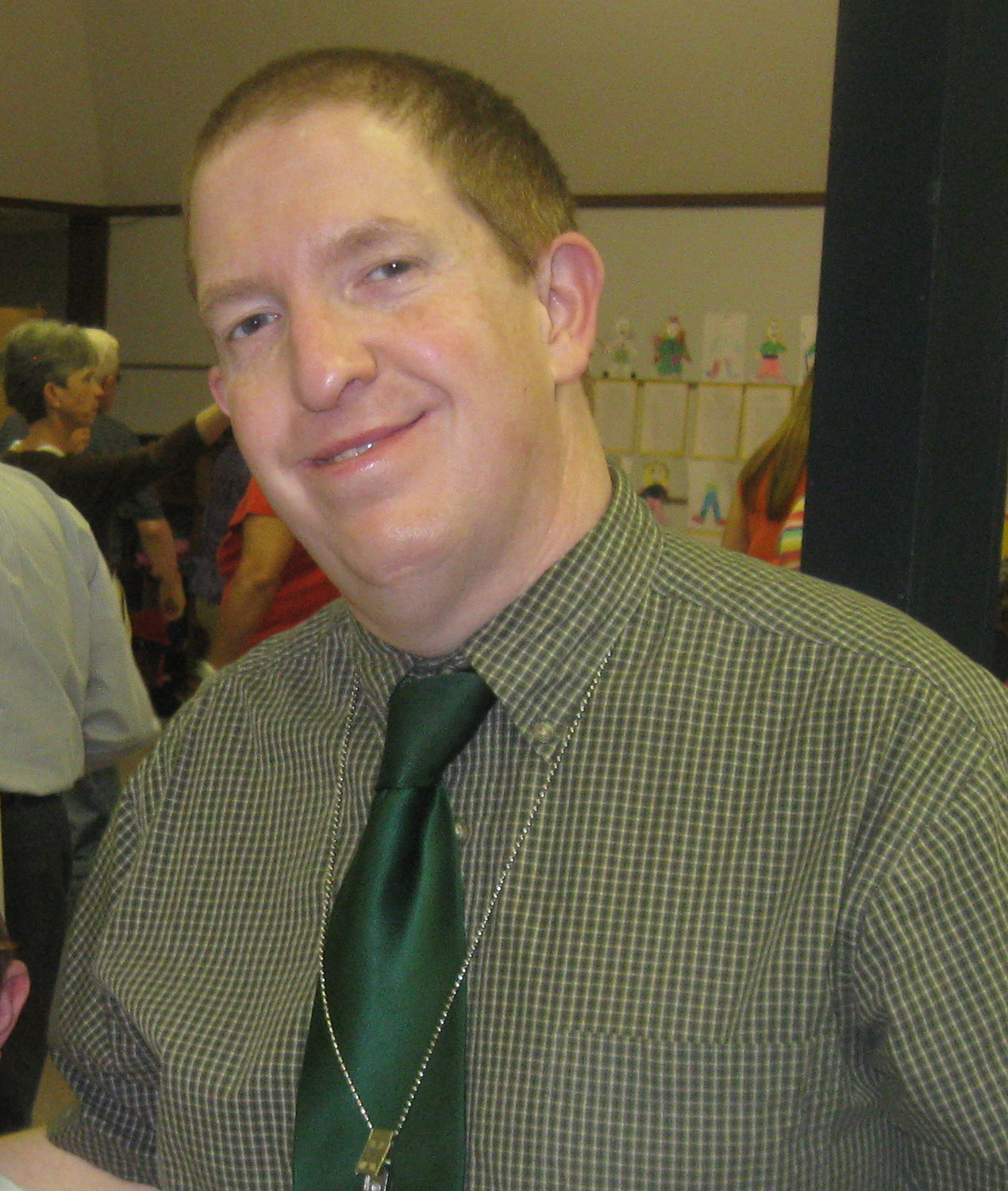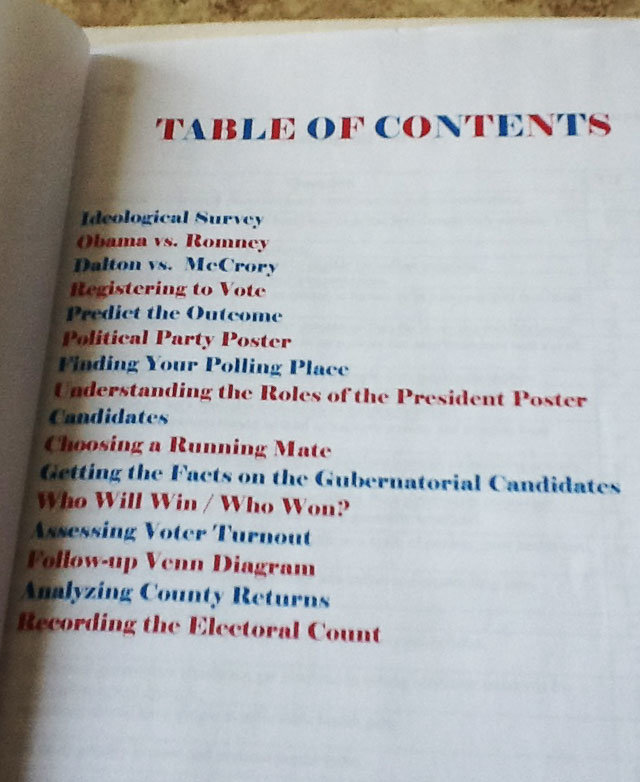2013 Dave Jones Award Winner: Patrick Vernon
SAMPLES
On Labor Day, September 2, 2013, The Times-News, Burlington, N.C. published a story about Patrick Vernon's teaching and his receiving the Dave Jones Award. The story is reprinted on this site with permission of The Times-News. Patrick Vernon, a social studies teacher at Western Middle School in Alamance County, was chosen to receive the Dave Jones Award for his use of news and information to engage students during an election. Below, social studies teacher, Patrick Vernon answers questions about his use of local news and current events in his teaching. Students learned about candidates’ positions on various issues and compared the candidates’ choices with their own. Before the fall election, students found out when and where citizens voted in their home county, and, after the election, they charted results on state and national maps.
Q: When and where did the unit on elections begin and end?
Students in my 6th grade class worked on the unit from late September to mid-November. They used two or three class periods each week to cover the election, while continuing their study of Ancient Civilizations, the standard curriculum for 6th grade social studies. (www.ncpublicschools.org/docs/acre/standards/new-standards/social-studies/6.pdf)
Q: Were other teachers involved?
I made available election resources to all social studies teachers in the school, so they could choose some part of the election curricula for use in their classes. The election study helped prepare students for the school-wide mock election conducted before the actual election.
Q: What resources did you use to focus on local news and current events?
My students and I read reports about candidates and events in the print and electronic editions of the local newspaper, The Time-News. We watched videos available through the local newspaper’s NIE page and portions of gubernatorial debates on WRAL.com. We compared positions that candidates had taken on issues with statements they made during debates. We also used an election tabloid that our local newspaper provided for every student and found information to complete the lessons outlined in that student section. Having resources readily available encouraged collaboration then and in the future on units involving government officials at all levels and public policies. (Note: Lesson plans related to this unit can be found on this site: http://allthingsvoting.org/lesson-plans/ )
Q: How did this unit foster inquiry and investigation?
A survey asked students to agree or disagree with statements about hot-button issues, such as health care, the death penalty, crime and poverty. Students then examined their own and candidates’ political philosophies. They reflected on candidates’ actions and whether those were in line with their stated positions. Students also conducted research to find out their voting districts for the N.C. Senate, N.C. House and U.S. Senate. They also learned where and when to vote early. Students were asked to identify five registered voters who planned to vote, a requirement that encouraged students to discuss voting with parents and other family members and friends.
Q: How did you assess student learning?
I assessed students’ culminating election scrapbook. They set goals based on a “Scoring Pathway” that outlined what they had to have in their scrapbook to receive certain grades. They chose which and how much to delve into topics. A unit on elections requires that teachers focus on having students locate and report on information and remain fair and impartial in their review of students’ viewpoints, so participation and presentation figured large in assessments.
Q: What did you learn from this project?
I got to know my students and their specific views. I found out such things as their ideal candidates and their plans for registering as a Democrat or Republican. I spoke of ways the unit prepared students for the future. They become eligible to vote in eight years. They will weigh questions and concerns raised in this unit throughout their lives. I found out too that no one stops learning. A simple explanation that I provided a colleague was used to help a 91-year-old in a retirement community understand how a candidate who won the popular election could lose the electoral vote and the election.
Q: You have used newspapers throughout your teaching career. Why do you use current events in social studies? What approaches/strategies have worked best for you and other teachers with whom you have worked?
The local Newspaper in Education program started during my first year of teaching. I was eager to sign up. NIE was and is a great opportunity to have a current text delivered to my classroom each week. Current events connect my students with the world. Technology allows citizens to pick and choose topics and have news and information delivered through email and social media while newspapers address and make students aware of other issues, expanding their interest in and knowledge of topics that affect their communities, state, nation and world. Recent changes to the Essential Standards for social studies established Ancient Civilizations as the curriculum for my sixth graders. In my class, I make connections between ancient and current events. The region of Mesopotamia was the Cradle of Civilization and saw constant shifts in power from Babylonians to Hittites to Assyrians. In current events, modern nations in the area, such as Syria and Iraq, continue to experience power struggles. (Note: The Essential Standards supports students’ learning to transfer knowledge across time, “During this study, students will learn to recognize and interpret the ‘lessons of history,’ those transferable understandings that are supported throughout time by recurring themes and issues.”) Over my years in teaching, I have had students work in pairs to dissect the content of an article (close reading) as well as investigate elements of a newspaper. Students have engaged in discussions about current events to find the humor or hidden meaning in political cartoons. Students have created their own political cartoons. Discussing election campaigns integrates well when my language arts colleague focuses on persuasive writing in her classes. Fellow social studies teachers have involved their classes in school-wide mock elections.
Q: How have you made use of technology?
I have used a variety of media to engage my students. My students and I have discussed news stories online through web logs (blogs). I’ve encouraged students to comment on stories and respond to other students’ comments. I have shown students how to use my local newspapers’ e-editions and NIE resource pages and navigate websites, such as WRAL.com and the @NCCapitol section on government. Creating and maintaining my school’s website led to seamless integration of technology in my classes. When I ask students for teachers’ catchwords, they respond quickly that mine is, “Let’s go to my website.” Twenty-first century learners live in a world of technology, but they must learn how to harness online information and choose accurate, objective and up-to-date news sources.




